
Targassonne is a beautiful village in the French Pyrénées, 10 minutes from Spain, an hour from Andorra, with access to skiing, hiking, canyoneering and even thermal baths. All this surrounding a world class granite boulder field (you'll find the words "second only to Font in France" in every other article about it), with pretty much every other form of climbing within a one to two-hour drive. Yet over the years Targassonne has acquired a reputation as the place that's eternally "about to be the next big thing." But maybe that's for the best…
The Area
Targassonne (or Targasona or Targassone) is located in the Cerdagne area of the eastern Pyrenees, at an altitude of 1500m, close to Andorra and Spain. The village itself is very small, but nearby Egat (5min) has medium sized supermarkets and Font Romeu (10min), one of the oldest ski resorts in France, has all manner of shops, boulangeries and restaurants.
If you're looking for some cheaper food or gear, it can be worth heading over to Spain or Andorra. The road out from Targassonne to the boulder field runs along the Spanish enclave of Llivia, but you'll have to drive 20 minutes down to Puigcerda to reach the Spanish main territory. Due to this proximity with Spain, many locals speak more Spanish than English, and you're likely to see at least as many Spanish as French climbers amongst the boulders!
There are boulder fields on pretty much every hillside in the area, apparently transported there from the nearby peaks by a long-gone glacier. The main area that has been developed is referred to as the "Chaos" of Targassonne, just outside the eponymous village. The guidebook lists around 1100 problems arranged into 17 areas within the Chaos. If that isn't enough for you, new boulders are regularly opened in the surrounding areas, though you may have to hunt down some locals to find out where and check if access has been granted by the land owners.
There has been climbing in the Chaos since at least the 70s and on several boulders, you can still make out the painted arrows of the original circuits. Nowadays the painted circuits are no longer maintained, and most people refer to the local guidebook, which contains many more problems that have been opened in the last couple of decades.
The Boulders
The rock is a very sharp and rounded form of granite. The landings are generally quite good (local ethics are fairly easy going when it comes to engineering landings so it's not rare to see chopped trees around the bottom of boulders), and there is climbing at all grades.
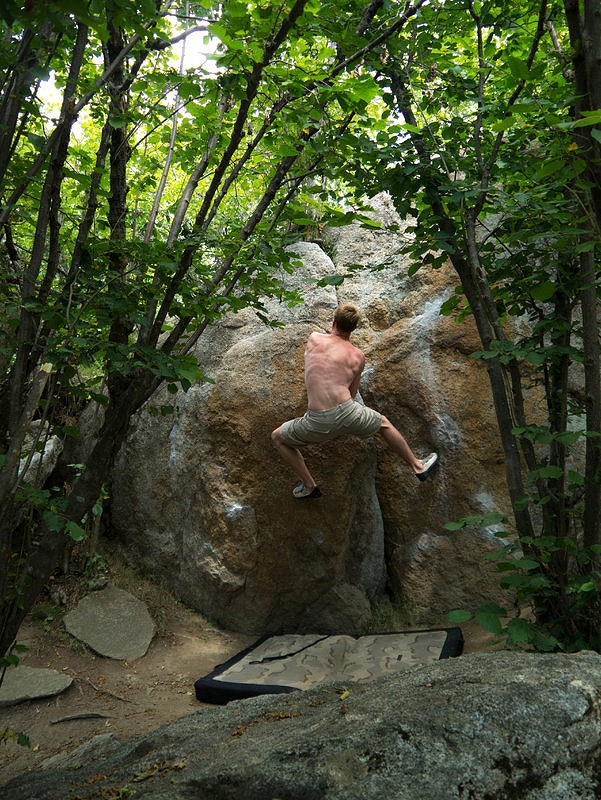
The boulders start just outside the village, after the campsite La Griole (Some are inside the camping grounds), and are spread for about a mile along the road. Access is pretty easy and there are many family friendly open areas. The only difficulty can be locating the problems through the small paths and similar looking boulders, but although the guidebook is a map topo that can take a few goes to get used to, you should quickly get the hang of it (All part of the fun!).
Many hard problems were opened in 2004 when a Petzl rock trip came to the area (check out "Targassonic" online to see Chris Sharma, Dave Graham, Phillippe Ribiere, Jacky Godoffe and others explore the area – worth it just for Dave Graham's multi-lingual description of the Chaos).
With over 1100 problems to choose from, there will be something for everyone. If you're looking for popular areas that tend to have nice open areas and a good mix of grades, try out the sectors of "Aigle", "Dieux Paiens" and "Taz". If it's shade and lower temperatures you want, then head south of the road, to "3 Grasses", "Arche" or "Canal".
The Boulder Problems
In the lower end of the spectrum, be sure to check out Klange (4+) and Hey Yop (5+) , before moving on to the lovely roof of Hugo Frais (6A) and the arete Beauty Phal (6A+).
If you then feel ready for the higher 6's, head over to Scato no Vice (6B+), scare yourself on the highball layback On s'y Croirait (6B+), make it across the pumpy traverse La Balance (6C) and try going up the arete of Elixir (6C).
Now you're warmed up, time to give what is maybe THE classic of the area a go, La Baleine (7A). Whilst your arms are fired up, why not give the overhanging Pleasure Dome (7A+) and Bottant Botton (7B) a go?
If you're still around, maybe try the beautifully highball arete of La Proue (7B+), before moving on to Chris Sharma's Bob's Your Uncle (7C) and finishing off with Nazgul (7C/7C+). If it's the 8th grade you're looking for, Targassonne still delivers, try checking out Psoas Hole (8A) and Creatura (8B).
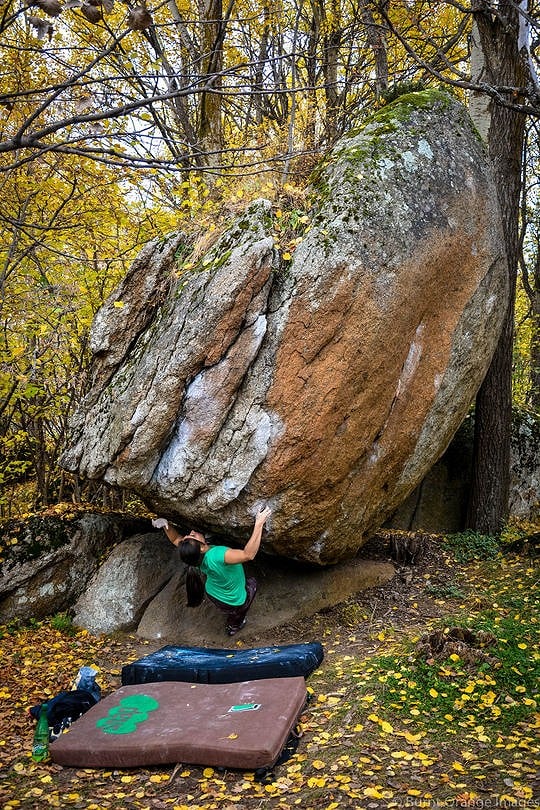
Of course, no bouldering destination is truly complete without a good list of dynos, so if you're looking for some air time, look no further. Warm up on the barely dynamic Mange Plat (6A) , before loading up the pads to try the high but flat landed (Help!) Jesus Revient (7A) and Lily Bop (7A+). If this all sounds too easy, Dave Graham apparently thought Flagellum Daemonium (7C) was tough for its grade. All you've got left to do is to top Orgasm Machine (7C+) and Superman (8A+) for the full Targa dyno experience.
A short video from Highball productions featuring some of the harder lines at Targassonne:
Other climbing
Being in the middle of the Pyrenees offers quite a few climbing alternatives in every direction and in every style, on granite and on limestone. A few single pitch sport crags are available within half an hour's drive (Roc d'Aude, etc.), as well as multi-pitch climbing within an hour (Vernet le Bain, etc.). Towards Perpignan the two-mile-long crag of Vingrau hosts a variety of lines. In the other direction, just over an hour's drive away are Andorra and the Ariege, which are home to multi-pitch trad climbing (Pic D'Orlu), sport climbing (Tarascon), more bouldering, as well as Via Ferratas. Finally, crossing the border in to Spain will get you to some of Catalunya's best sport crags in less than 2 hours (Oliana, Sierra de Cadi). Most of these destinations would be worthy of stand-alone guides, but there is certainly plenty to go around!
Other activities
Given the abrasive nature of the rock, you might want to find some rest day activities even on a short trip. Luckily, this being a mountain area, you'll find all the usual suspects, and more. Your best bet to find out more is to start in Font Romeu, where depending on the season you'll find all you need for skiing (there are 9 ski resorts within 20k), mountain biking, canyoneering, paragliding, rafting and more. Many hiking and running trails also set off from Font Romeu, as well as from the back of the campsite.
Other options are to check out the Odeillo solar furnace, the largest of its kind in the world, or the Themis solar power plant (the tower just behind the boulder fields). The region is also famous for its thermal baths (Saint-Thomas et Llo), and you could of course head over to Andorra or Spain for some more standard tourism.
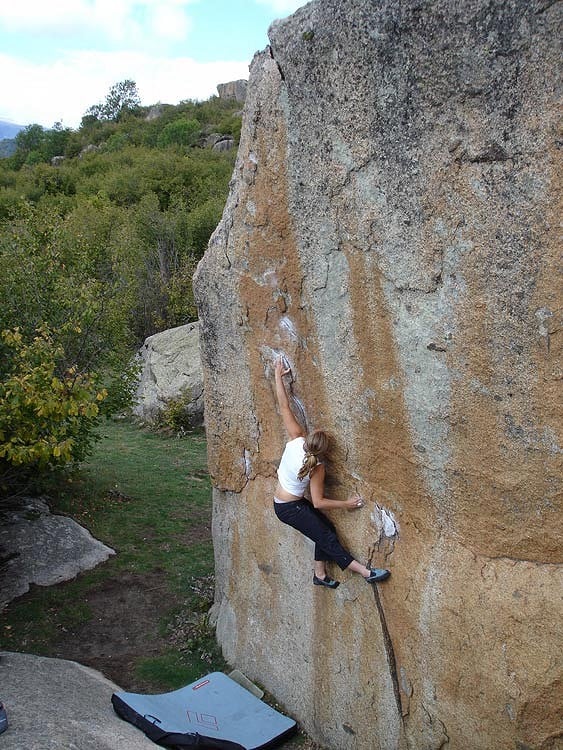
Logistics
When to Go
As with many European bouldering areas, you can go all year. The best friction is found in winter, but temperatures can drop to -10C at night and there can be snow on the boulders – nothing to stop the inevitable shirtless bouldering session, but less appealing for those wanting a more comfortable experience. Summer temperatures can get quite high, though climbing is still possible in the shade and/or evening. Spring and Autumn are usually the sought-out compromise.
How to Get There
Here might lay the explanation as to why Targassonne isn't more popular than it is, but though it is no Font in terms of accessibility, it's no harder to get to than Albarracin, Val Di Mello or Magic Woods. You can fly to and rent a car from Perpignan (95km - 1hr30min), Barcelona (180km - 2hrs15min) or Toulouse (200km - 2hrs45min).
Accommodation Advertise here
No Premier Listings found in this area
The usual option is Camping La Griole (Van, tent, mobile-homes & chalets, heated WIFI room for cold days, bar in summer). Many other campsites and gites around the area, especially towards Font Romeu.
Food and Supplies
There are several supermarkets nearby (Egat - Super U, Lidl), as well as restaurants in Font Romeu.
Gear
Pads can be rented from the campsite La Griole. Although they are a bit further, Andorra and Spain offer a cheaper alternative for food and gear.
Outdoor Shops Advertise here
No Premier Listings found in this area
Guidebook
"Le Chaos de Targasonne Topo Guide" (2008) by Fred Bertin is the current most complete guide. Although your first time using the maps might be a bit confusing (scales can vary from one area to the next), they are a fun part of the experience and once you've located a couple of lines using the few photos you'll have no problem finding your way round! The guidebook is available from the La Griole campsite.
The out-of-print E-bloc also features a selection of the boulders, and you may be able to find some outdated topos online.
Instructor/Guides Advertise here
No Premier Listings found in this area

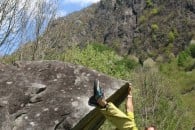






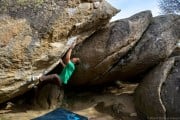



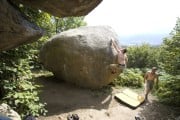
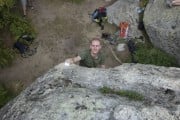









Comments